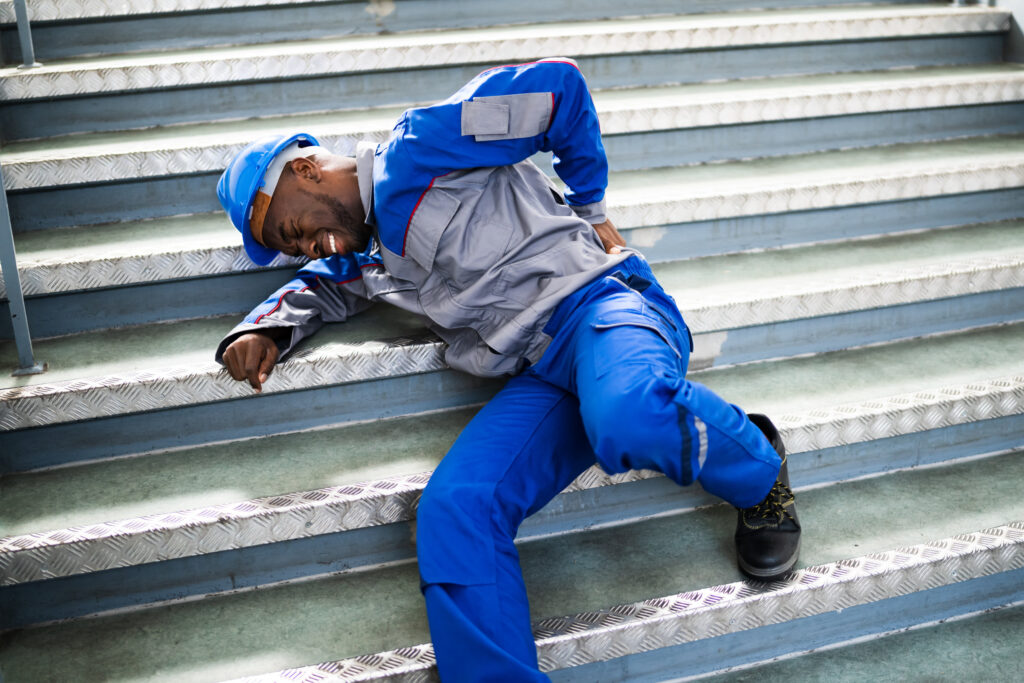
Each June, we spotlight National Safety Month by observing the National Safety Council’s (NSC) initiative to reduce injuries both in the workplace and beyond. Slip and fall prevention is an important part of that, as these incidents account for 12% of total falls that result in emergency room visits. Slip and falls at work are also the most common reason that workers aged 55 and older file worker’s compensation claims.
How to Reduce Risks of a Slip and Fall on Your Property
If you’re a property or business owner, it’s of utmost importance that you protect both your employees, your customers, and anyone entering the premises. There are many simple and practical actions you can take right now to potentially avoid a lawsuit in the future.
- Include workplace safety in employee orientation. Keep it on the agenda during meetings at least once a year. Make sure your team knows where “slippery floor” signs are located, in case they notice a spill or clean up a mess.
- Develop a worthwhile training manual and strategy so that everyone knows how to work equipment correctly.
- Make slip-resistant shoes mandatory.
- Update and maintain equipment.
- Keep a clear walking path throughout your facilities that is well-lit. Make sure rugs or cords lay flat.
There are things you can do to avoid slip and falls in your home as well. For example, keep the floor clear of debris and items that shouldn’t be there. Also, make sure floors are dry and stairs are well maintained.
How to Reduce Your Chances of Suffering a Slip and Fall at Work and Beyond
Of course, there are things you can do to protect yourself from slips and falls. To minimize your risk of injury, try these strategies:
- Wear well-fitting shoes.
- Don’t work outside if the weather is bad.
- Don’t cut corners–follow the instructions and training of your employer at all times.
- Make sure ladder extensions or step ladders are locked into position.
- If you have to climb, always maintain three points of contact between your hands and feet (knees and elbows do not count.)
- If you notice a hazard in someone’s home, don’t be shy. Point it out to them, and see how you can help fix it.
- Always scan a room for potential hazards before entering it.
Still, some incidents are unavoidable. So, if you are injured via slip and fall on someone else’s property, call the Chicagoland slip and fall lawyers at Lerner and Rowe today.
Related article: Avoiding Chicago Gardening Accidents
What Happens After a Slip and Fall Injury?
After your case evaluation and consultation, our attorneys will begin the process of determining liability. Illinois has their own set of laws about slip and falls, known as the Premises Liability Act. This law states that a property owner must provide a safe environment for anyone who enters their store, workplace, or other business. This is known as a duty of care, and it may be different depending on where the injury took place.
Moreover, in some cases, your lawyer may find that you can sue more than one negligent party, therefore maximizing your overall amount of compensation. All told, it’s best to have a knowledgeable Chicago slip and fall lawyer on your side, so that you don’t miss anything developing your case on your own.
Call the Slip and Fall Lawyers in Chicago at Lerner and Rowe
When you call Lerner and Rowe for assistance with your slip and fall case, you will set up a free consultation. We service the Chicago area and throughout the state of Illinois. Whenever you need us, we’re available–24/7 and even on weekends.
So, don’t hesitate to call us at 708-222-2222, fill out this FREE online form or text through our LiveChat feature. Your free case evaluation and consultation is your first step to potential financial compensation. We’re committed to providing excellent communications, so you will be on your way to financial compensation in just a few moments. The best part- there’s no fee until you win your slip and fall case. Reach out today.



